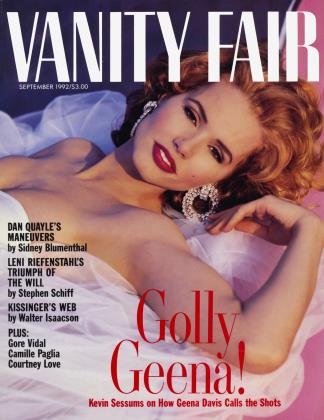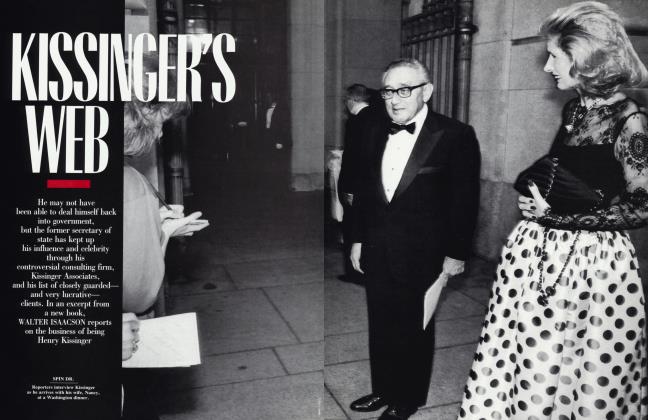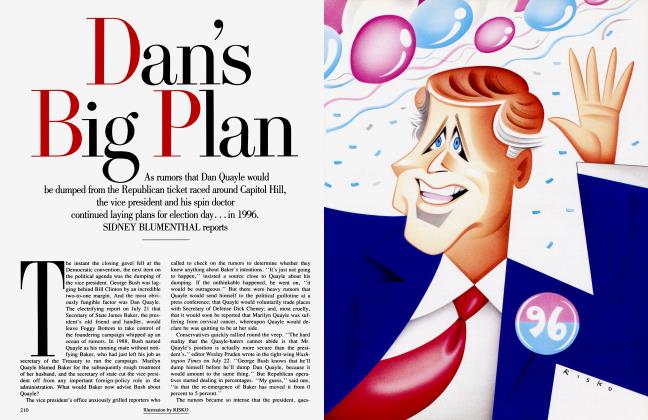Sign In to Your Account
Subscribers have complete access to the archive.
Sign In Not a Subscriber?Join NowEditor's Letter
Signing Off
This is the last issue of Vanity Fair under my editorship. The October issue will be edited by my successor, Graydon Carter, who comes to us from editing The New York Observer, Manhattan's sparky weekly broadsheet. It is a significant moment to be passing on the eyeshade. For the first six months of this year, Vanity Fair has surpassed a sale of one million copies in the United States—a source of great pride to all of us who, the glum early years, often felt like the band on the Titanic.
In 1984, media pundits were all banging on that people did not read anymore and that the general-interest magazine was dead. Nowadays, they like to blame the success of this generalinterest magazine on the glitz quotient, overlooking the true nature of its mix. V.F. is the quintessential postmodern magazine. It is the great high-low show, able to deliver Roseanne Barr mud-wrestling side by side with Chancellor Kohl cogitating, or Demi Moore's pregnant belly side by side with Martha Graham's dance aesthetic. It is a cross-cultural synthesis that adds up to more than the sum of its parts. It is all about context, and the context of Vanity Fair is conducive to reading.
The striking fact about our last eight years is that the more substance we added to the mix, the more we attracted and held our readers. In our pages, we were able to publish 15,000-word articles that gleamed all the brighter in their unlikely pagination. One thinks of Alex Shoumatoff's report on Chico Mendes, the first eco-martyr, or his odyssey in search of the source of AIDS in Africa, or, again, his depiction of the last days of General Stroessner. One thinks of William Styron's poignant confessional essay on his battle with depression and Norman Mailer's dissection of Bret Easton Ellis and of the Gulf War. One thinks of T. D. Allman's masterly and prescient foreign reporting from China, the Philippines, Panama, and Arafat's plane somewhere over the Middle East. One thinks of Stephen Schiff's cultural portraits, from John le Carre to Ryszard Kapuscinski. One thinks of the extraordinary range of Gail Sheehy's contributions, political profiles that made news again and again, and, most recently, her article on menopause, which now, in book form, rides at the top of the best-seller lists.
I bow out with a sense of loss. Vanity Fair is sustained by a unique creative family. E. B. White once said, "No one should come to New York to live unless he is willing to be lucky." I have been more than willing, but definitely lucky. Lucky to be spirited from London in 1984 by S. I. Newhouse Jr. and handed a magazine title that, in spite of a few local difficulties, reverberated with history and romance. Lucky that two intrepid Brits, editors Miles Chapman and Sarah Giles, jumped with me. Lucky to find, lashed to the mast, one of the finest text editors in publishing, Wayne Lawson, as well as the gifted art director Charles Churchward and writers as entertaining as Bob Colacello and as trenchant as James Wolcott. Lucky to lure the formidable Pamela McCarthy from Esquire to be a stellar managing editor, and Jane Sarkin from Interview to go mano a mano with Hollywood's toughest flacks and agents. Lucky for me and for the stars whom Jane produced that they could be enhanced by the magic wand of style director Marina Schiano. Lucky that the lenses we turned on the stars, and others, were focused by such legends as Annie Leibovitz and Helmut Newton. Lucky that the one writer I knew when I landed in New York was Marie Brenner, one of the most talented—and generous. It was at her house one night in my first week here that my dinner partner turned out to be a movie producer who told one compelling story after another. I asked him if he would ever think of writing stories like this for a magazine. Dominick Dunne did think about it, I am happy to say, and has given all of us so much joy. No wonder Frank Crowninshield, Vanity Fair's first editor, wrote a piece entitled "Ten Thousand Nights in a Dinner Coat." The best leads often come with the entree. We owe scoop after scoop to the orbitings of Caroline Graham in L.A. and Reinaldo Herrera everywhere else. And I was lucky, lucky, lucky that through it all I was kept on my toes by the Balanchine of magazines, Alexander Liberman, Conde Nast's fabled editorial director.
Vanity Fair, with new editor in chief Graydon Carter and the dynamism of publisher Ron Galotti, will continue to thrive and grow without me. Every exit is an entrance somewhere else. Mine will be at the helm of The New Yorker, which I believe is uniquely placed to comment and report on this defining moment in the American culture. To all V.F.'s creative family, and to you readers, especially those of you who have been with us since 1983, thanks a million.
Editor in chief
 View Full Issue
View Full Issue












Subscribers have complete access to the archive.
Sign In Not a Subscriber?Join Now